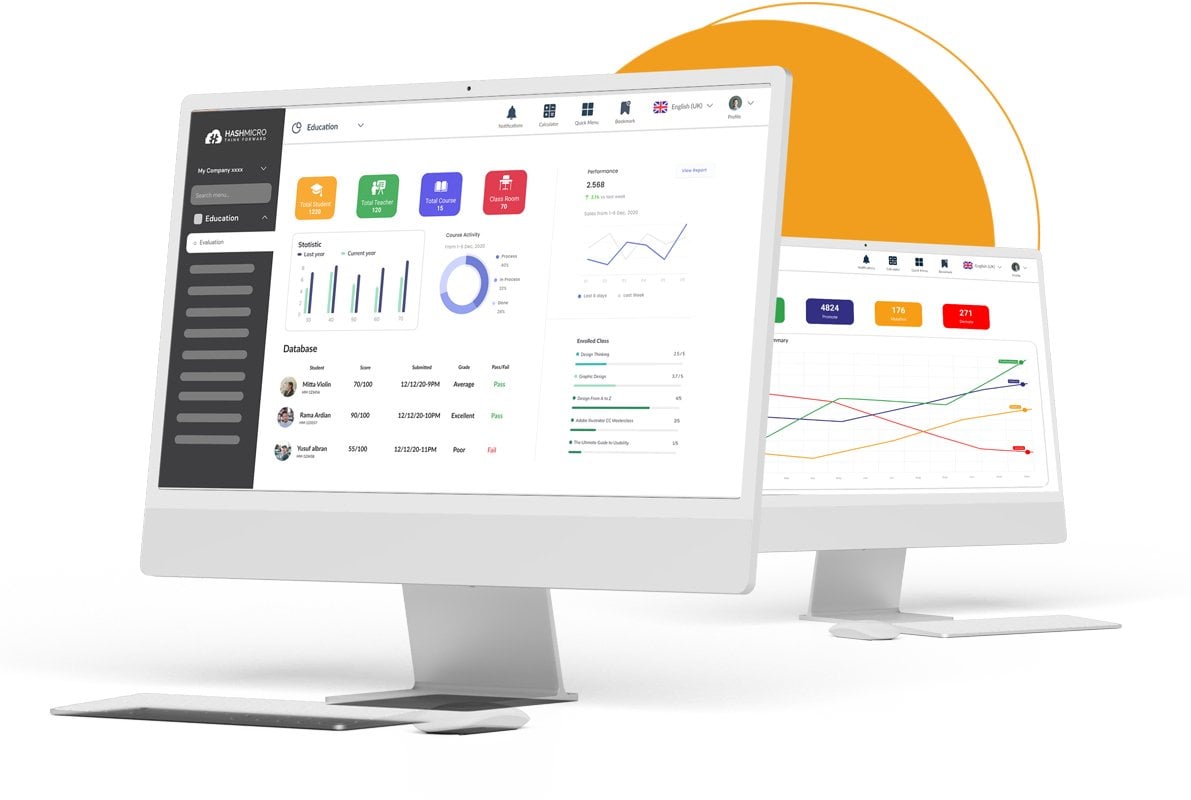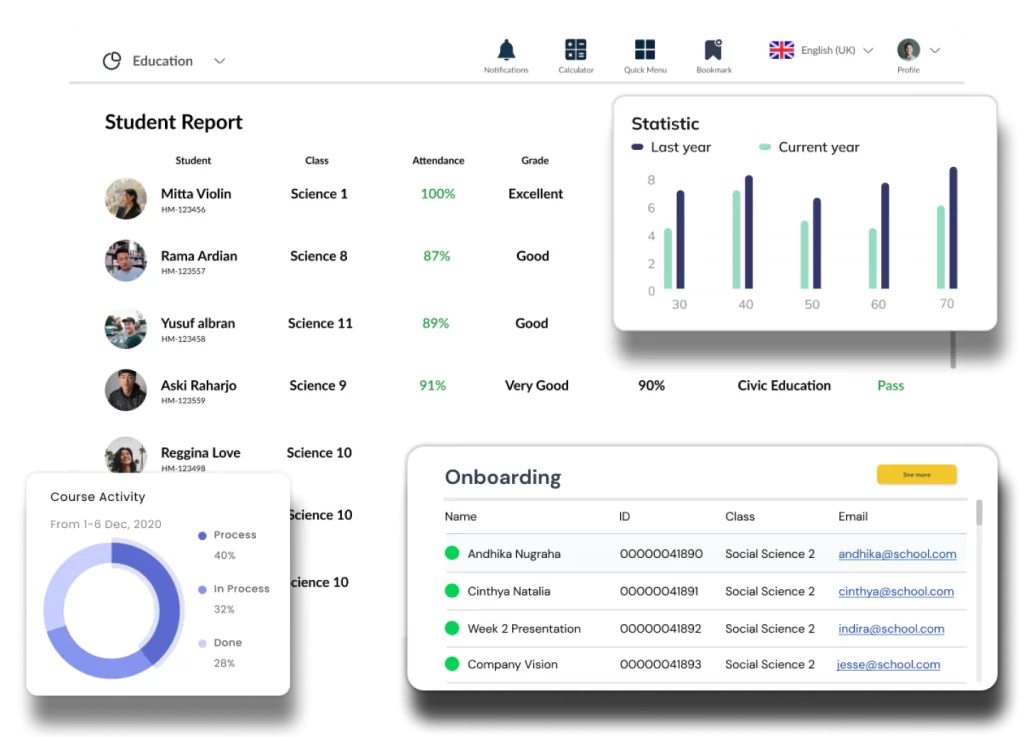In a bustling educational landscape like Singapore’s, the school management system not only streamlines administrative tasks but also ensures seamless collaboration among teachers, staff, students, and parents.
This is particularly significant in Singapore’s school management system, where strong partnerships between home and school are highly valued to support students’ holistic development.
Moreover, Singapore’s focus on leveraging technology aligns perfectly with the functionality offered by school management systems. The centralized platform allows for efficient communication, academic planning, and resource management, fostering a conducive learning environment tailored to meet Singapore’s high educational standards.
One of the best school management systems in Singapore that you can use is the school management system from HashMicro. This system has complete features such as schedule management, student attendance tracking, financial management, and communication between teachers, students, and parents. By using HashMicro’s school management system, educational institutions can improve operational efficiency and ensure that administrative processes run smoothly.
Here are the reasons why the school management system is important for schools in Singapore.
Key Takeaways
|
Table of Content:
Table of Content
What is a School Management System?
A School Management System is a comprehensive software solution designed to streamline and automate the administrative and academic processes within educational institutions. It encompasses various functionalities such as attendance tracking, grade management, communication channels, fee processing, and resource allocation.
By integrating these processes into a centralized platform, the top school management software enhances efficiency, fosters collaboration among teachers, staff, students, and parents, and supports the overall management of the school.
Types of School Management
Different types of School Management Systems serve various aspects of school operations. Understanding the distinctions and benefits of each system helps schools choose the right tools to improve efficiency, support student learning, and optimize overall administration.
1. Student information system (SIS)
A Student Information System stores and manages detailed student records, including grades, attendance, and personal information. This foundational component of a school management system supports educators in tracking student progress and ensuring compliance with educational standards.
2. Learning management system (LMS)
An LMS facilitates online learning by organizing and delivering course content, assignments, and assessments. Integrating with a school management system enhances learning experiences, provides centralized access to resources, and improves communication between students and teachers.
3. Finance and accounting system
This component of a school management system handles financial tasks like tuition billing, payroll, and budgeting. It streamlines the financial processes, reduces manual errors, and ensures financial transparency across the institution.
4. Human resource management system (HRMS)
The HRMS component manages staff-related functions, including recruitment, payroll, performance evaluations, and compliance. By integrating HR tasks with the overall school management system, schools can improve efficiency and promptly meet staffing needs.
Benefits of Using a School Management System
A school management system integrates various administrative, academic, and operational tasks into a centralized platform, improving efficiency and performance across all school activities. With the growing need for digital transformation in education, especially school management, these systems have become crucial tools for schools to streamline workflows and enhance communication.
1. Centralized data management
A school management system consolidates all student, staff, and academic data into one platform, making it easy to access and manage. This reduces errors, saves time, and provides better insights into student performance, attendance, and academic progress.
2. Automation of administrative tasks
Routine tasks like attendance tracking, grading, and scheduling are automated within an SMS, reducing the manual effort required by school staff. This saves time and ensures that administrative duties are performed consistently and accurately.
3. Improved communication
An SMS enhances communication between teachers, students, and parents by providing a unified platform for updates on assignments, grades, school events, and notices. It facilitates quicker resolution of issues and strengthens stakeholder relationships, contributing to a more supportive educational environment.
4. Real-time data access and decision making
School management systems allow administrators and educators to access real-time student progress, attendance, and behavior data. This access enables faster decision-making, helping to identify students who need additional support or intervention early on.
20 Importance of School Management System in Singapore
Schools are considering implementing the right software to boost their activities and learning systems. Get the school system pricing scheme calculations here to estimate the budget effectively. If your institution considers implementing the right school management software, these points below might reassure you!
1. Attendance record just in a few clicks
Recording and reviewing students’ attendance is just one of the school management system’s basic yet super useful features. It allows teachers to formulate reports with various matrices automatically.
Moreover, with the complete school management software, teachers can use the SMS feature to notify parents if their children are absent. Therefore, parents will get a notification indicating that the teacher has received a sick notification or leave of his child.
The student attendance system also alerts parents if their children skip classes without permission. Surprisingly, this simple feature also acts as a disciplinary tool.
2. More organized (online) materials with school management system
The education management system has one component, allowing students to download, upload, and complete assignments, notes, and projects. This component is e-learning management. The system is accessible if used simultaneously. They can attach various documents to the system as long as authorized.
It also helps them review past lessons by accessing the uploaded materials. If the school provides proper tech assets, they don’t have to carry all the heavy textbooks in their backpacks.
It’s a well-known fact that students share their study materials and lecture notes with each other via the StuDocu sharing platform, which simplifies their preparation for the lesson. It’s time to pay more attention to our kids’ backbone health!
3. Better exam management
Another important feature of this system is how it helps teachers conduct exams. They can upload the exams, randomize the questions to prevent cheating, and use various exam formats.
Using the system, their creativity in assessing the students is not limited. Plus, it saves students time during the exam by not spending too much time using an eraser or per correction.
However, if teachers prefer traditional paper-based exams, the education management system can help them by keeping the students’ grade records. Then, they can generate and calculate students’ performance throughout the semester.
Teachers can immediately post exam results so students and their parents can find out.
4. Effortless fee payment with school management system
At the beginning of the semester, parents or students will usually queue at the bank to get a turn to pay tuition. Luckily, the system provides a channel through which they can pay online.
Implementation of the school management system is a method to minimize late payment issues, thanks to the SMS feature that sends updates about fees that parents have not paid.
5. Effective communication
This system has a feature that effortlessly connects parents, students, teachers, and school admins. Blasting SMS, emails, or specific notifications regarding school activities is no longer a burden. The information about recipients is already stored in the system, so you don’t need to input it manually.
6. School management system can track school vehicle
The system allows the school to monitor the vehicle route and odometer by using IoT integration. It also schedules the vehicle’s maintenance to maximize its life span.
Taking good care of the vehicle will increase parents’ confidence in the school because they know their children’s safety is in good hands.
7. School management system helps student’s admission
The beginning of the semester is often perceived as one of the most daunting periods for school. They need to process hundreds to thousands of student applications. Thankfully, the system helps schools eliminate such chaos by implementing an online admission system.
Prospective students simply upload all the required documents to the system, and the school can review them without worrying about losing them.
After students are accepted, they will upload their personal data and documents to the system, which will then save them. Thus, they can always access them, even after their graduation.
Lastly, school management must minimize mistakes due to human error and lost or duplicated documents. Many students need academic assistance, so Varsity Tutor Reviews is here to provide it.
Looking to revolutionize your school’s management system and enhance efficiency? Discover the comprehensive features of School Management System HashMicro.
Click on the banner below to explore our pricing schemes, which are tailored to suit your institution’s specific needs and budgetary requirements!
8. Parents can access it too
The school information management system connects schools and parents directly. It informs the parents about their children’s development and learning progress without waiting until the end of the semester or the occasional parents’ conference.
This information is available anytime, from student performance to ongoing projects. Hence, parents and teachers can work hand-in-hand to fulfill their responsibility in teaching the youth.
9. School management system streamlines staff management
This benefits teachers, school management, and administration, improving the HR staff’s workflow efficiency. They can keep track of other staff’s attendance, leaves, performance, and salary calculations without a hassle.
Therefore, they can focus more on ensuring teachers’ welfare, improving all staff performance, and developing better hiring decisions.
10. Workable inventory management
Some schools have a store that sells school supplies, uniforms, or books. A good inventory management system helps the school inform the available stocks and items that are about to run out and automatically creates purchase order requests.
Hashy AI Fact

Need to Know
Hashy AI streamlines school management by automating tasks like attendance and grade management. This allows educational institutions to focus on more important aspects of teaching and learning, enhancing operational efficiency.
Request a free demo today!
11. Proactive multi-tasking
If the administrative process takes a lot of time for just one student, how much time is needed for student administration in one school? With the help of an integrated school management and administration system, administrative work to send learning outcomes reports to parents can be done with just a few clicks.
Teachers and staff management of the school can use their valuable time to do other things simultaneously.
12. Personalization of the school management system
If your school will have a unique program such as special classes, extra classes outside of school hours, and other activities. A customized school information management system will be very helpful in meeting the needs of your school program.
13. Improving the quality of school delivery (scheduling attendance)
Various facilities that support the teaching and learning process will also bring changes to the quality of education, this is why the need of school management exists. With this school information management system, students, teachers, school staff, and parents can view the schedule in one software application.
14. Amenity management
Basic facilities that support learning activities, such as classrooms, laboratories, teaching staff rooms, toilets, and gymnasiums, to small and large equipment such as paper, projectors, computers, lab equipment, various types of balls for sports classes, or even wifi networks require effort to can be well managed always to be available when needed.
Facility management software helps you monitor your needs and automatically schedule maintenance in one integrated system.
15. Acknowledging the role of parents
School management systems provide accessible information to students, teachers, school staff, and parents, including syllabus information, subject matter, student activity, and assessment.
Parents can monitor what their children are interested in and need to develop again. This information is very important so that parents are aware of their children’s development at school.
16. Reporting and analytics
The main reason for implementing an education management system is that all parties involved in school activities can easily get reports and analyses for maximum results.
17. Multi-school management
If you are an educational organization with various types of schools, such as elementary, middle, and high school universities or schools located in many different locations, school information management system software can help you in the daily operational management of school activities.
18. Simplified payment process
Parents often face the challenge of managing school-related expenses, such as tuition, boarding, and transportation fees. A school management system streamlines this process by providing a centralized platform where parents can easily view and track their financial obligations.
Notifications are sent when payments are due, including a detailed breakdown of the fees. Additionally, the system offers online payment gateways, enabling parents to make transfers conveniently. Each transaction is recorded and reflected on the app profile, ensuring transparency and ease of verification.
19. Real-time notifications for homework and exam performance
Educational management is a collaborative effort between teachers and students, with both playing crucial roles. A school management system enhances this collaboration by notifying parents when their child falls behind on homework or performs poorly in exams.
Early alerts to parents allow them to intervene and help redirect their child’s focus. Additionally, parents can view accurate exam results through the app, keeping them informed about their child’s academic progress and enabling timely support.
20. Paperless documents
A school information management system automates documentation processes, eliminating the need for physical storage spaces for important details. This benefit extends to parents, who no longer need to keep track of paper documents.
Payments, applications, and other important records are accessible through a dedicated profile for each child. This digital approach reduces reliance on paper, ensuring that both schools and parents can manage important information efficiently and securely.
Key Components of a School Management System
- Admission: Simplifies the enrollment process by efficiently managing applications, documentation, and student records.
- Fees Management: This system automates the collection, tracking, and reporting of tuition and other fees, ensuring timely payments and financial transparency.
- Student Assessment: Provides tools for tracking academic performance, grading, and generating progress reports, thereby supporting personalized learning experiences.
- Academics: Encompasses curriculum planning, scheduling, and resource allocation, facilitating effective teaching and learning processes.
Key Aspects of School Management
Effective school management involves several key aspects that ensure the smooth running and success of educational management. These aspects include:
- Planning: It involves setting goals, developing strategies, and outlining the necessary steps to achieve the desired outcomes. It also involves setting academic objectives, budget planning, and resource allocation.
- Organizing: Structuring the school’s resources and activities to support achieving its goals. This includes creating schedules, assigning tasks, and coordinating efforts among staff and students.
- Leading: Guiding and motivating staff and students to achieve the school’s objectives. Effective leadership involves communication, fostering a positive school culture, and providing support and direction.
- Controlling: Monitoring progress and implementing corrective measures to ensure the school’s plans are followed and goals are met. This includes evaluating performance, managing student discipline, and maintaining quality standards.
How to Choose a School Management System
When selecting a school management system, several factors must be considered to ensure the system will meet your school’s unique needs and support the broader educational goals. A well-chosen system can streamline administration, enhance communication, and improve student outcomes.
1. Scalability and flexibility
Choose a system that can grow with the school’s needs, whether expanding to accommodate more students or adding new features over time. A scalable school management system ensures you don’t need to replace the software as the school evolves or new educational needs arise.
2. User-friendliness
The system should be intuitive and easy for all users—teachers, students, and administrators—to navigate. A user-friendly school management system reduces the training burden and ensures quicker adoption by everyone involved.
3. Integration with existing systems
Ensure the school management system integrates seamlessly with your school’s other tools, such as learning management systems (LMS), student information systems (SIS), and financial software. This allows for smooth data flow and eliminates the need for redundant data entry.
4. Strong support and security
Look for systems that offer reliable customer support, security features, and data protection measures. A secure, well-supported system ensures that sensitive student and staff data is protected and that any issues can be quickly addressed.
How to Implement a School Management System
Successfully implementing a school management system requires careful planning, structured rollouts, and ongoing support to ensure its full adoption and effectiveness in the educational management environment. A well-managed implementation process helps maximize the benefits of the system and ensures long-term success.
1. Define clear implementation objectives
Before introducing the SMS, set specific objectives, such as reducing administrative overhead, improving parent-teacher communication, or automating grade reporting. This will help you measure the system’s success and align it with the school’s strategic goals.
2. Train users and provide ongoing support
Effective training is essential for smooth adoption. Ensure that teachers, staff, and students understand how to use the system, and provide continuous support to address any technical or usability challenges as they arise.
3. Start with a pilot program
Implement the system in phases, starting with a small group of users or a single department, to identify potential challenges before full implementation. A pilot program helps uncover issues early, minimizing disruption and ensuring a smooth rollout.
4. Evaluate and improve continuously
Regularly assess the performance and effectiveness of the school management system by collecting feedback from users. This continuous evaluation ensures the system adapts to evolving needs and maximizes its value for all stakeholders.
You can also read other articles related to Littlelives alternatives, exploring more options and detailed comparisons to help you make an informed decision.
Conclusion
The school management system’s importance lies in its ability to streamline and optimize school administration through its multifaceted and robust features.
From facilitating seamless collaboration among teachers, staff, and external stakeholders to bridging communication gaps between the school, students, and parents, this centralized platform is a cornerstone in modern educational institutions.
For those seeking a tailored solution that perfectly aligns with their school’s operational dynamics, HashMicro’s School ERP System is a comprehensive solution.
Experience firsthand this system’s comprehensive functionalities and efficiency-enhancing capabilities, designed to elevate your school’s management processes to new heights. Explore our free demo today to take the first step toward revolutionizing your school’s operations!

FAQ
-
-
What is the function of educational management?
Educational management plans, organizes, directs, and controls resources to achieve educational goals effectively and efficiently. It ensures the smooth operation of educational institutions and enhances the quality of teaching and learning.
-
What are the characteristics of educational management?
Educational management includes leadership, strategic planning, decision-making, resource management, and continuous improvement. It involves collaboration among various stakeholders and emphasizes accountability and outcomes.
-
What do you mean by education management?
Education sector management is the administration of the education system, aiming to ensure effective teaching and learning. It works by creating, maintaining, and improving supportive environments within educational institutions and administration to promote efficiency, collaboration, and sustainable learning outcomes.
-




























































